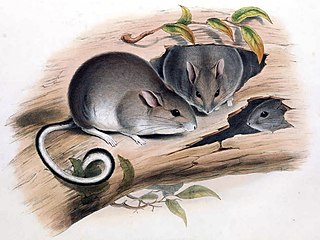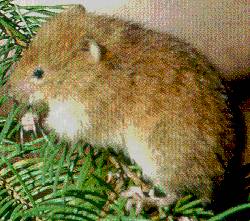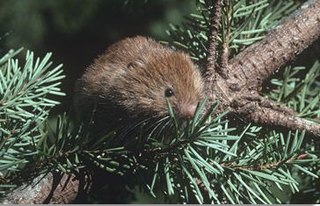
The white-footed rabbit rat is an extinct species of rodent, which was originally found in woodlands from Adelaide to Sydney, but became restricted to south-eastern Australia. It was kitten-sized and was one of Australia's largest native rodents. It was nocturnal and lived among trees. It made nests filled with leaves and possibly grass in the limbs of hollow eucalyptus trees. The mother carried her young attached to her teats. In a letter to John Gould, then Governor of South Australia Sir George Grey said that he removed a baby from a teat of its dead mother. The baby clung tightly to Gould's glove.

The genus Arborimus is a group of voles found in western North America. The genus name is Latin for "tree mouse". Some sources include this genus with the heather voles, genus Phenacomys, and both are classified in the tribe Phenacomyini.

The red tree vole is a rodent of the Pacific Northwest, found in the US states of Oregon and California. They were formerly known as Phenacomys longicaudus and have also been called the red tree mouse.
The Sonoma tree vole or California red tree mouse is a species of rodent in the family Cricetidae. The species is found in northwest California. The preferred habitat for this primarily arboreal vole is old-growth Douglas-fir forests.

The brush-tailed rabbit rat is a species of rodent in the family Muridae. It is found in Australia and Papua New Guinea.
The Ethiopian white-footed mouse or white-footed stenocephalemys is a species of rodent in the family Muridae. It lives in Ethiopia and Eritrea. Its natural habitats are tropical moist montane forest and tropical high-altitude shrubland.
Stenocephalemys is a genus of rodent in the family Muridae. The genus is endemic to Ethiopia.

Eleutherodactylus albipes is a species of frog in the family Eleutherodactylidae endemic to Cuba. Its natural habitat is subtropical or tropical moist montane forest. It is threatened by habitat loss.
The white-footed frog, or white-footed trilling frog, is a species of frog in the family Limnodynastidae. It is endemic to the Esperance mallee ecoregion of Australia. Its natural habitats are temperate shrubland, Mediterranean-type shrubby vegetation, intermittent freshwater marshes, and seasonally flooded agricultural land.

The Mexican gray squirrel is a tree squirrel in the genus Sciurus native to Guatemala and eastern and southern Mexico. It has been introduced to the Florida Keys.

Technomyrmex albipes, commonly known as the white-footed ant, is a species of ant first described in 1861 from Sulawesi, Indonesia by the British entomologist Frederick Smith. Invasive pest ants in Florida, previously identified as T. albipes, have now been separated as Technomyrmex difficilis, both forming part of a species complex with a worldwide distribution.

Neuroterus albipes is a gall wasp that forms chemically induced leaf galls on oak trees which has both bisexual and agamic generations and therefore forms two distinct galls, the smooth spangle gall and Schenck's gall. Neuroterus laeviusculus and Spathegaster albipes are previous binomials found in the literature.

Androlaelaps fahrenholzi is a species of mite in the genus Androlaelaps of the family Laelapidae. It occurs throughout the contiguous United States, where it has been recorded on the following mammals:
The Capricorn rabbit rat is an extinct species of rodent from Queensland, Australia. It was described as a new species in 2010 on the basis of Pleistocene and Holocene dental remains. The specific name refers to the Capricorn Caves in Queensland, one of the locations where remains were unearthed. Some of the subfossil material post-dates the European settlement of Australia, so the Capricorn rabbit rat is a modern extinction. Since there has not been a targeted survey for the Capricorn rabbit rat, there is a thin hope of its survival, although this is unlikely.

Titanacris is a genus of large grasshoppers in the subfamily Romaleinae and tribe Tropidacrini. They are found from southeastern Mexico, through Central and South America, ranging south to northernmost Argentina.

Phenacomyini is a tribe of voles in the subfamily Arvicolinae. It contains five species in two genera, all of which are found in North America.
This page is based on this
Wikipedia article Text is available under the
CC BY-SA 4.0 license; additional terms may apply.
Images, videos and audio are available under their respective licenses.












